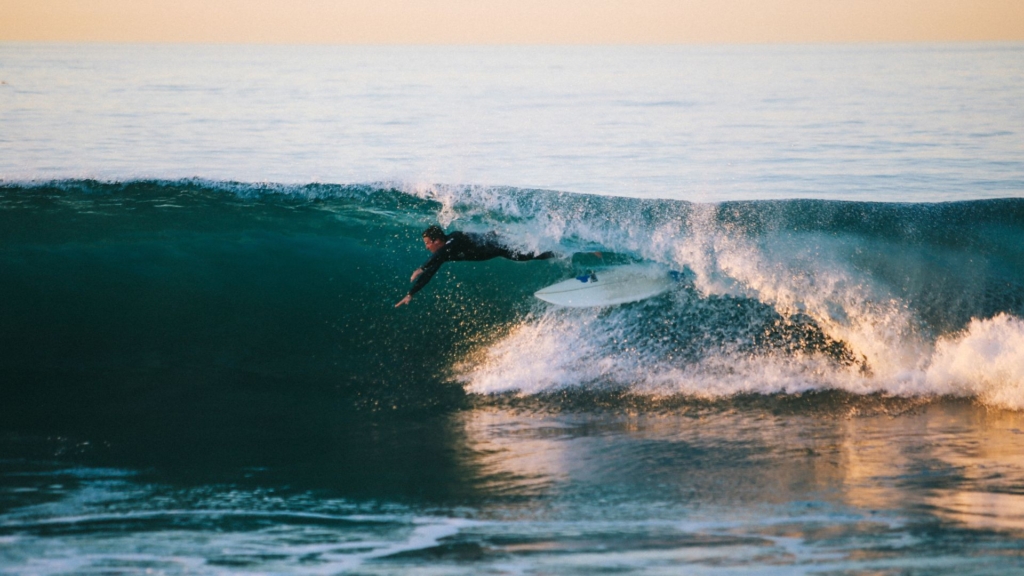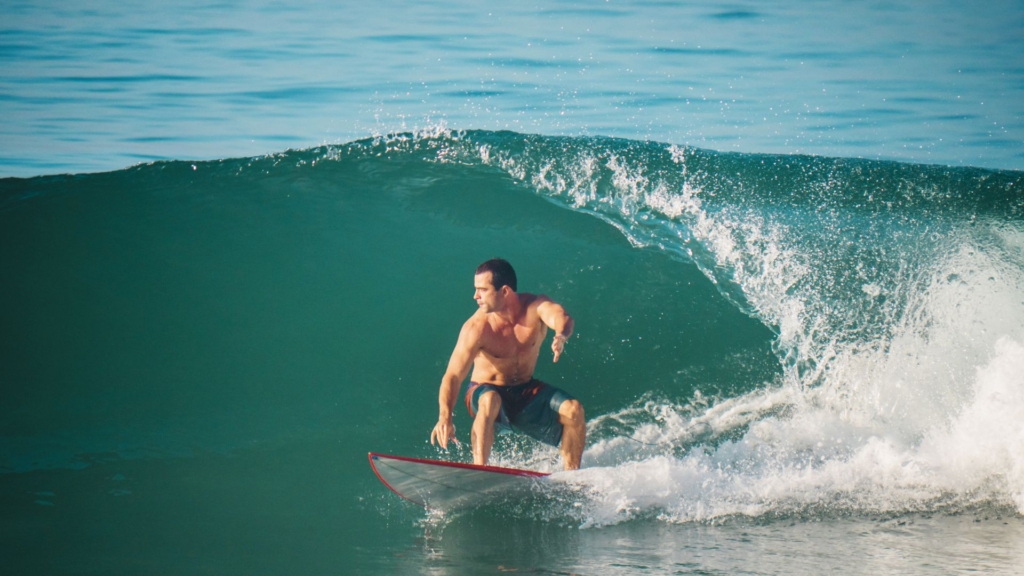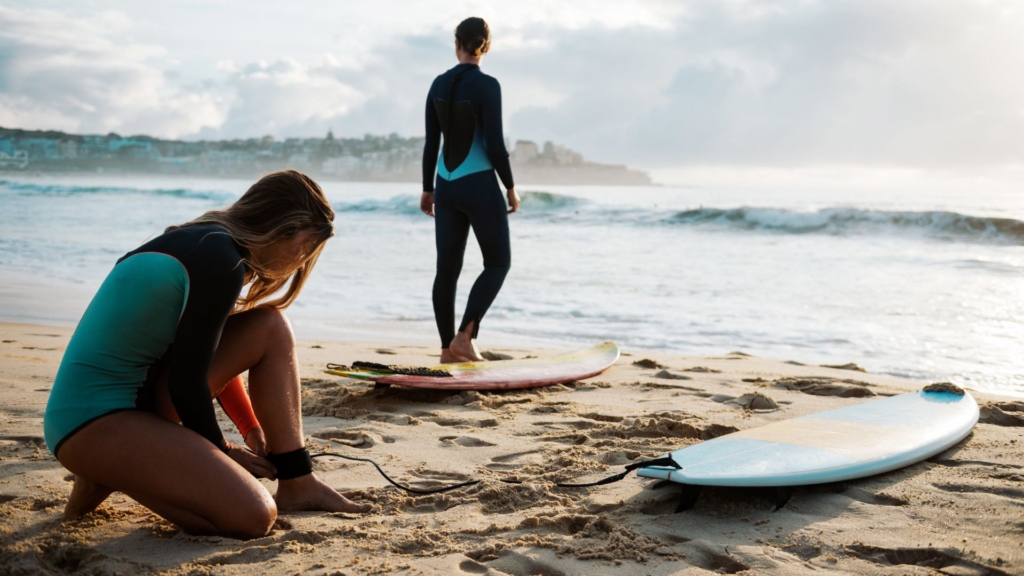Surfing is an exciting sport loved for its wave-riding thrills, but it also comes with certain risks; naturally comes the question: “Is surfing dangerous?”. This article focuses on challenges like strong ocean currents and meeting sea animals. It’s not just about highlighting the dangers; we also discuss safety measures and responsible surfing practices. Whether you’re just beginning or a seasoned pro, these insights are here to make your surfing experience safer and more enjoyable.
13 Most Common Risks When Surfing
Surfing, a sport many love with its blend of thrill and connection to nature also brings possible risks. In addressing the questions “How dangerous is surfing?” and “Is surfing dangerous?”, we focus on the 13 most common risks of this exhilarating activity.
1. Drowning
This risk mainly arises when strong waves keep surfers underwater or if they get too tired from swimming against the current.
The best way to mitigate this danger is to choose waves that match the surfer’s skill level, maintain physical fitness, and always have a surfing companion.
2. Collisions
Collisions are a common danger in surfing. They happen when surfers bump into each other, hit rocks, or crash into their own boards.
Surfers also often get hurt by their own boards, especially from the sharp fins and nose, which can cause serious cuts.
To lower the risk of these accidents, choose appropriate surfing locations based on skill level, remain constantly aware of surroundings and other surfers, follow surfing rules, including ‘right of way’ rules, use a surf leash, and consider protective gear like helmets in high-risk situations. Respecting other surfers and the shared space in the water to reduce collision risks and maintain a safe surfing environment.
3. Sharks
While statistically rare, shark encounters are a risk that surfers should be aware of while out in the water.
The shadow of a surfer on a board can sometimes be mistaken by sharks for the shadow of a seal, especially when viewed from below.
Most shark encounters do not result in an attack, and many surfers surf for years without ever seeing a shark.

4. Riptides and Currents
Riptides and currents pose significant risks as they are strong and directed. They have the potential to quickly carry a surfer out to sea and make returning to shore a significant challenge.
Such situations can cause rapid exhaustion and, in extreme cases, heighten the danger of drowning.
To stay safe, surfers should observe the water before entering to spot inconsistent areas indicating rips and undertows. Importantly, if caught in a strong current, calm yourself and swim across, not against, then wait for it to subside before paddling back to shore.
5. Marine Life Encounters
Encountering marine life like sharks, seals, jellyfish, and sea urchins is a part of surfing in the ocean’s diverse ecosystem.
The chance of a shark attack for the global surfing population, estimated at 35 million, is incredibly slight, marked at just 0.00018%. But surfers should still keep their eyes peeled in the water. If surfers encounter potentially dangerous marine animals, a rare occurrence, the safest course of action is to exit the water promptly.
6. Wave Power
Waves are present as powerful and unpredictable; these waves can lead to injuries from falls or hitting the surfboard. A big wave carries a significant amount of force, making maneuvers like duck diving nearly impossible. Furthermore, when such a wave breaks, it can pose serious risks, including bone fractures, prolonged submersion underwater, and even slamming surfers against the ocean floor.
The ocean’s dynamics can be particularly challenging for those unfamiliar. Surfers must know the day’s wave conditions and their limits to stay safe. Choosing waves that are right for your level of experience to reduce the chances of getting hurt.

7. Surfboard Injuries
Localism in surfing refers to territorial behaviour by surfers living near a particular surf break. It often manifests as resentment towards surfers from other regions and active discouragement of their participation.
8. Localism
Localism in surfing refers to territorial behavior by surfers living near a particular surf break. It often manifests as resentment towards surfers from other regions and active discouragement of their participation.
This form of territoriality can lead to hostile environments, particularly at popular surfing locations. The sense of “us versus them” is prevalent in areas with higher amplitude waves, where localism can negatively impact the overall surfing culture and experience. Understanding the local surf culture and respecting local surfers and their customs is essential to navigating localism.
9. Beginners and Disrespectful Surfers
Beginners, or ‘kooks’ as they are sometimes called, face challenges in surfing, particularly when they are unaware of the sport’s strict rules.
Missteps like entering the water without assessing conditions, ignoring locals, and attempting to surf beyond one’s skill level can lead to accidents and conflicts.
Additionally, poor etiquette, like wave stealing or blocking other surfers, can create tension in the water.

10. Hypothermia
Surfers face two major temperature-related risks: hypothermia in cold waters and heatstroke from too much effort or sun. Hypothermia can occur in cold water, leading to shivering, confusion, and extreme tiredness. It’s a big deal, especially during long surfing sessions.
On the other hand, there’s also the risk of heatstroke, which can happen from working too hard in the water or spending too much time in the sun. To stay safe while surfing, surfers need to be mindful of both extremes: the chill of the water and the warmth from physical effort or sun exposure.
11. Sun Exposure
Spending a lot of time surfing means you’re getting plenty of sun exposure, and this increases your chances of skin cancer, including basal cell carcinoma as the American Academy of Family Physicians highlights this risk.
It’s a wise choice to use a water-resistant sunscreen with a minimum SPF of 30 to reduce it. Apply it about 20 minutes before you go into the sun. Don’t forget to shield your face, ears, and neck with a wide-brimmed hat for added protection. Plan your surfing for the early morning or late afternoon when the sun isn’t as strong. This way, you can hit the waves and still be mindful of sun safety.

12. Ear Infections and Surfer’s Ear
The risk of ear infections and surfer’s ear for surfers mainly comes from consistent and prolonged exposure to cold water and wind.
Such a problem happens when unusual bone growths develop in the ear canal, which can trap water and bacteria, leading to ear infections and hearing issues. The more a surfer is in cold water, the higher the risk.
Prevention includes avoiding extreme cold or windy conditions and keeping ears warm and dry using protective gear.
13. Impact with the Sea Bed
Surfing involves risks associated with the ocean environment, including impacts on the sea bed. According to expert Andrew Nathanson, as referenced on Mpora.com, 18% of surfing injuries occur upon impact with the ocean floor.
Head and spinal injuries are significant risks, especially when surfing in powerful waves breaking in shallow water.
How Dangerous is Surfing?

Surfing does carry an inherent risk of injury. Yet, the overall injury rate is relatively low, ranging from 2.2 to 3.5 injuries per 1,000 surfing days, as cited in Gitnux’s latest report. As for surfing deaths, although there is no exact data on this, estimates suggest no more than 10 fatalities per year among approximately 23 million surfers worldwide; this rate is also a remarkably low figure.
Via such statistics, it is clear that surfing is generally safer than many other water-based and contact sports, while not without risks.
Looking closer, approximately 72.7% of surfers experience injuries, mainly lacerations (60-70%) and head injuries (36.8%). Collisions with other surfers cause about 36% of these injuries, while 38.5% occur during activities like paddling or wave-catching. This underscores the need for surfers to learn safety measures and get the right training to reduce these risks.
11 Surf Safety Tips

Surfing is an exhilarating sport that connects you with the power and beauty of the ocean. However, it’s essential to prioritize surf safety to ensure an enjoyable and injury-free experience via these tips.
- Wear a Leash: This keeps your board close by and prevents it from becoming a hazard to others.
- Use Sun Protection: Protect your skin with sunscreen, a rash guard, or a wetsuit, and consider wearing a hat for extra coverage.
- Know Your Limits: Surf within your ability level and gradually challenge yourself with bigger waves.
- Understand Rip Currents: Learn to identify and safely navigate out of rip currents.
- Surf with a Buddy: Always have at least one person with you for safety and assistance.
- Stay Aware of Your Surroundings: Keep an eye on the ocean conditions and other surfers to avoid accidents.
- Warm-Up Properly: Engage in stretches and warm-up exercises to prevent injuries.
- Check Your Equipment: Ensure your surfboard and fins are in good condition before leaving.
- Listen to Locals: Heed local surfers’ advice regarding the area’s specific dangers and conditions.
- Stay Hydrated: Drink water regularly to prevent dehydration, especially on hot days.
- Learn Basic First Aid: Acquaint yourself with how to treat common surf-related injuries like cuts and marine stings.
Following these guidelines, being prepared and cautious helps you enjoy the waves with peace of mind.
Catch the Waves Innovation
Like any sport, surfing carries its risks but is generally not as dangerous as often regarded when it comes to “Is Surfing Dangerous?” especially with proper safety measures and awareness.
The Boost Surfing Fin leads the charge in remarkable, safe surfing tech; this electric fin, easily attachable to any board in about 5 minutes, offers improved performance with features like 20 pounds of thrust, speeds up to 10mph, and safety elements.
It also comes with a remote and app for customizable settings, significantly contributing to safer and more efficient surfing experiences. Therefore, for those interested in elevating their surfing experience with an added layer of safety, explore Boost Surfing to catch a wave that lingers in memory.


Share:
How to Generate Speed Surfing on a Surfboard?
13 Surf Safety Tips for a Safe Adventure